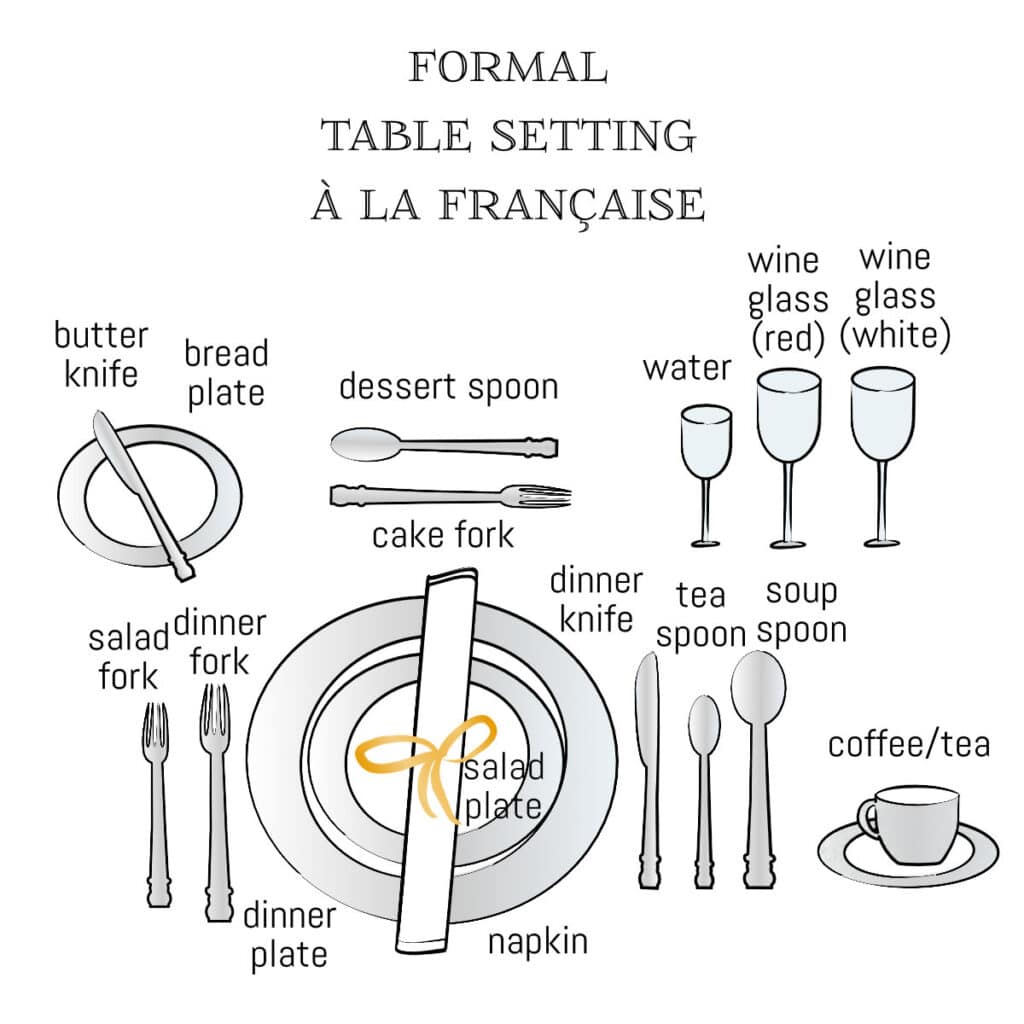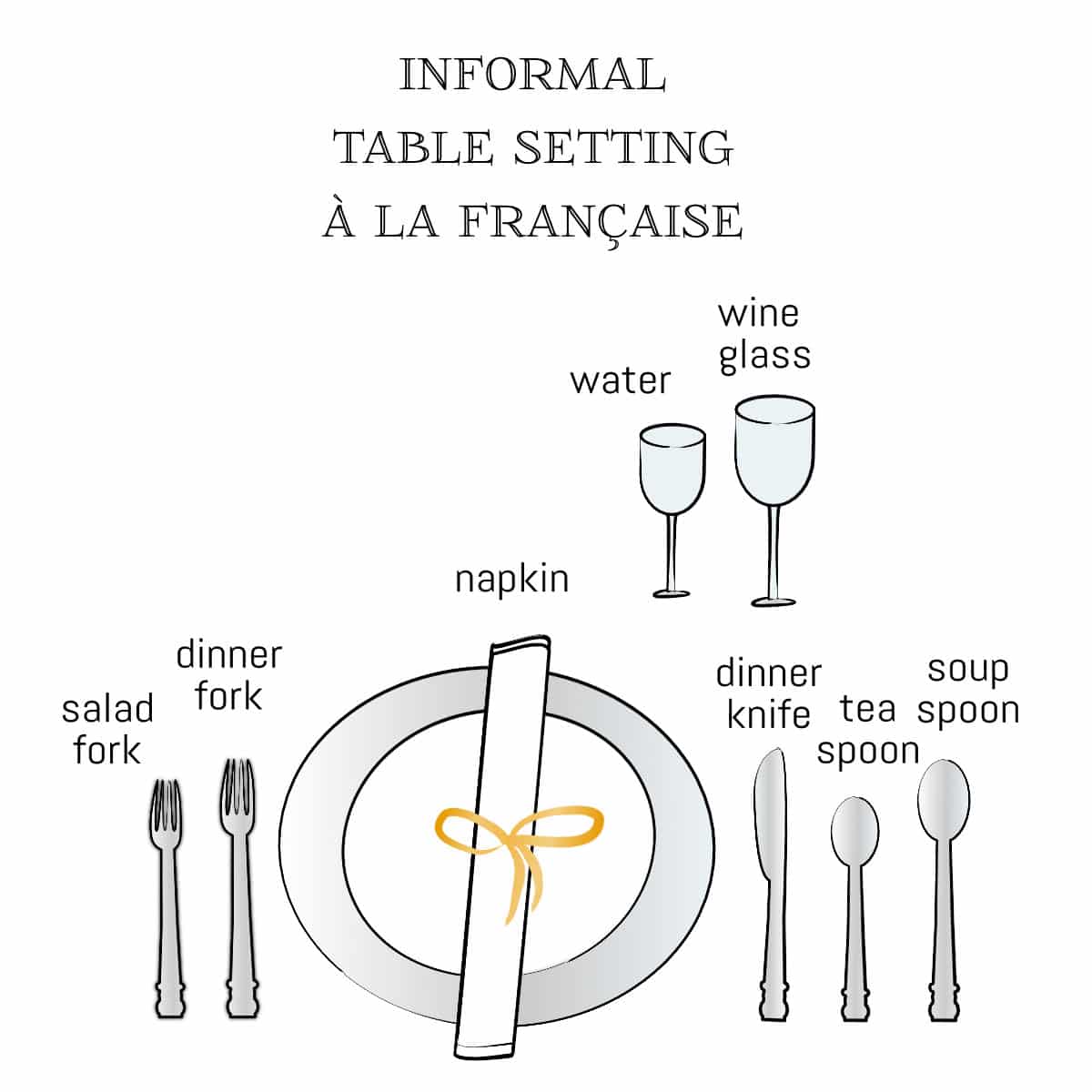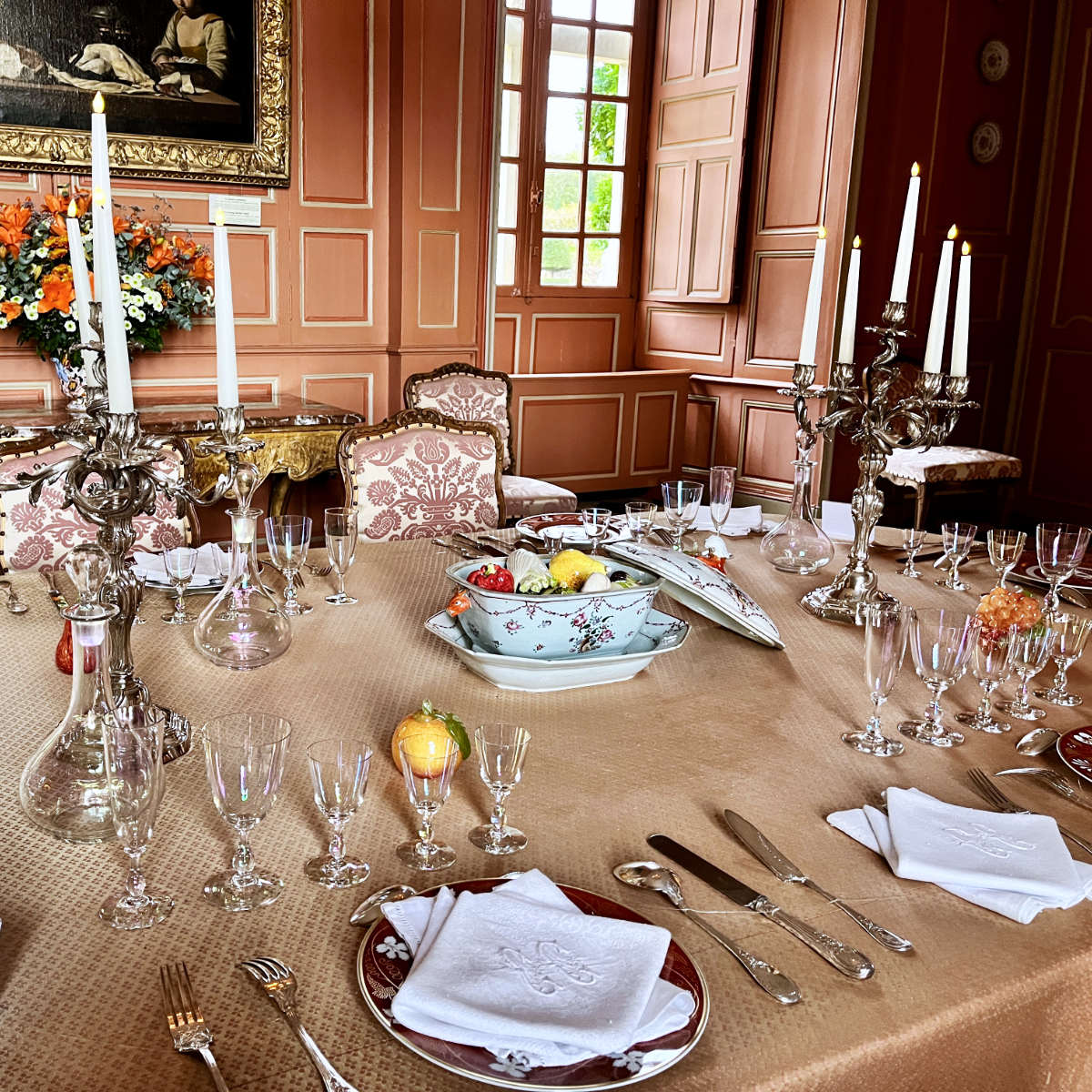When I got married, a lovely French friend offered me an elegant set of cloth table napkins. I’m sure I looked at her oddly, but she let it slide.
Weren’t cloth napkins just for restaurants? I put my observation skills to the test (basically put my glasses on!), and a few dinner parties later, I realized that even the table setting for dinner at home involved napkins. The “Art de la Table“, as it is called.
How to set a table in France
Now the French like formality on most occasions, and dining and etiquette is no different. If you are having a formal dinner party, it is expected that there are many courses, and many wines to go with each course.
This means multiple plates, multiple sets of cutlery, and multiple glasses. As such, the french formal table setting looks like this:

If that seems like a bit too much, there is the French informal table setting. Even en famille for a sunday lunch for example, the table will be set in the Informal table setting below.

You will notice a few interesting things in the above illustrations. For one, there is a napkin in both the formal and informal setting. French people really do use cloth napkins when they eat. It is more ecological than paper.
Another is that the glass for the water is also in goblet format. It is just an added touch of class added to the “fine dining experience”. It is also quite nice to include older children and those not imbibing in wine, in the experience.
And finally, even with their great love of baguettes, the French informal setting doesn’t include a bread plate, since French people usually place the bread directly on the table. (A table cloth is recommended.)
The Art de la Table
The Art of the Table is defined as the art of preparing and presenting the meal in elegance and conviviality.
To put it more simply, you are not supposed to gulp down your meal in France. The chatter of loved ones, the feel of soft linens and spotless cutlery, the smell of a heavenly dish, and finally the taste. It is all meant to sing together to be the highlight of your day, to relax and unwind.
Right about now you’re thinking, who eats like that!? At home, with kids? Even if French kids supposedly eat everything, watching a 4-year-old trying to eat messy spaghetti will hardly be relaxing.
The History
But let’s rewind
But where the Art really took off and democratized was after the French Revolution in 1789. French aristocrats had fled or had their heads chopped off, leaving behind vast armies of chefs and servers needing employment. These unemployed
New industries sprung up around tableware and
But today even the French can’t maintain that level of exigence every night. A normal workday for office workers in Paris ends around 6-6:30 pm, and after commuting home, picking up the kids, bathing them, etc., the French are just as time-pressed as anyone.
French hack to fine dining
Now, you are probably looking at the above table settings and thinking that even the informal table setting looks too formal!
But I’ll tell you one of the secret weapons in all this: frozen food. I’m kidding of course, but not that much.
The Art of the Table doesn’t actually have much to do with the food. Especially on a daily basis, after a long day at work. There is a reason that Picard, a gourmet frozen meals grocery chain, is usually within walking distance of every neighborhood in Paris. There you can find everything from full meals to side dishes,
The real secret is not the main meal, but everything else. You can set the atmosphere with an interesting tablecloth and napkins. Add a few delicious staples such as gourmet cheese, baguette, and fruit. Et
So try it tonight, pull out the fancy cloth napkins, slap together a quick meal with a good bottle of wine, and spend 2 hours over a lazy dinner with loved ones. L’Art de la Table is the process, rather than the destination. (Maybe after that 4-year-old is in bed though.)
☞ READ MORE: Easy Guide to the French Wines
Shop Favorites:
- 24-piece Plate set for 6 – by Villeroy & Boch
- 12-piece red and white wine glass set for 6 – by Libbey
- 38-piece cutlery set for 6 – by Belleek
- 8-piece serving dishes – by Godinger Silver Art Co.
- Champagne flutes for 6 – by House of Hampton
- 23-piece tea set for 6 – by August Grove

☞ READ MORE: ABC of French Cuisine (the Food Dictionary)
If you want to learn some French-English keywords about the Art de la Table, download our free flashcards below. And if you enjoyed that article, you may want to read more about what a typical dinner in France is like, with all its courses. A bientôt!






I totally agree with eating in style as a daily habit. I don’t drink wine with all my meals (sometimes, though) but I use linens and pretty tableware. So much is learned at the family table: how to converse, how to divide the amount of food among people present, getting to know and support your family members, table manners, patience. It teaches us to value what is in front of us in the here and now.
As soon as my daughter grew out of the high chair, I started buying interesting looking china dishes at yard sales. These were her dishes that she used with every meal because I wanted her to learn that dishes break (I just didn’t want her to learn on mine!). By the time she was 4, she was able to eat from the fine china. We still have that little stack of dishes (most, anyway).
Remember, if it is a habit to eat meals in front of the tv, your child will learn that tv is the most important thing in the home.
That sounds like a great idea! It is true, my kids were telling me that at 4 in their school canteen they have to carry their own tray to their seat, and nobody drops anything! So we just assume as adults that they can’t manage, but actually they can 🙂
Hi there, I enjoy reading through your post.
I wanted to write a little comment to support you.